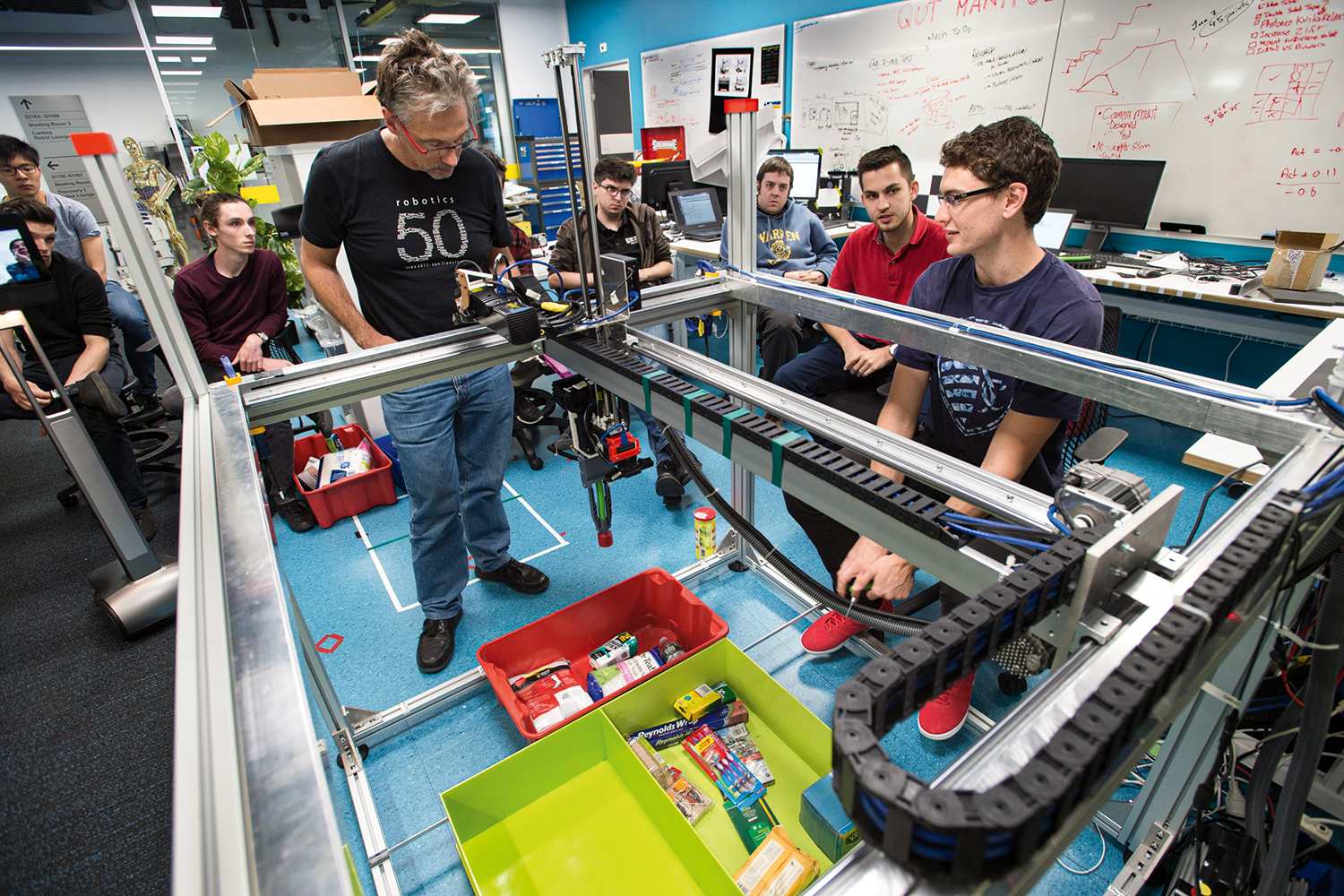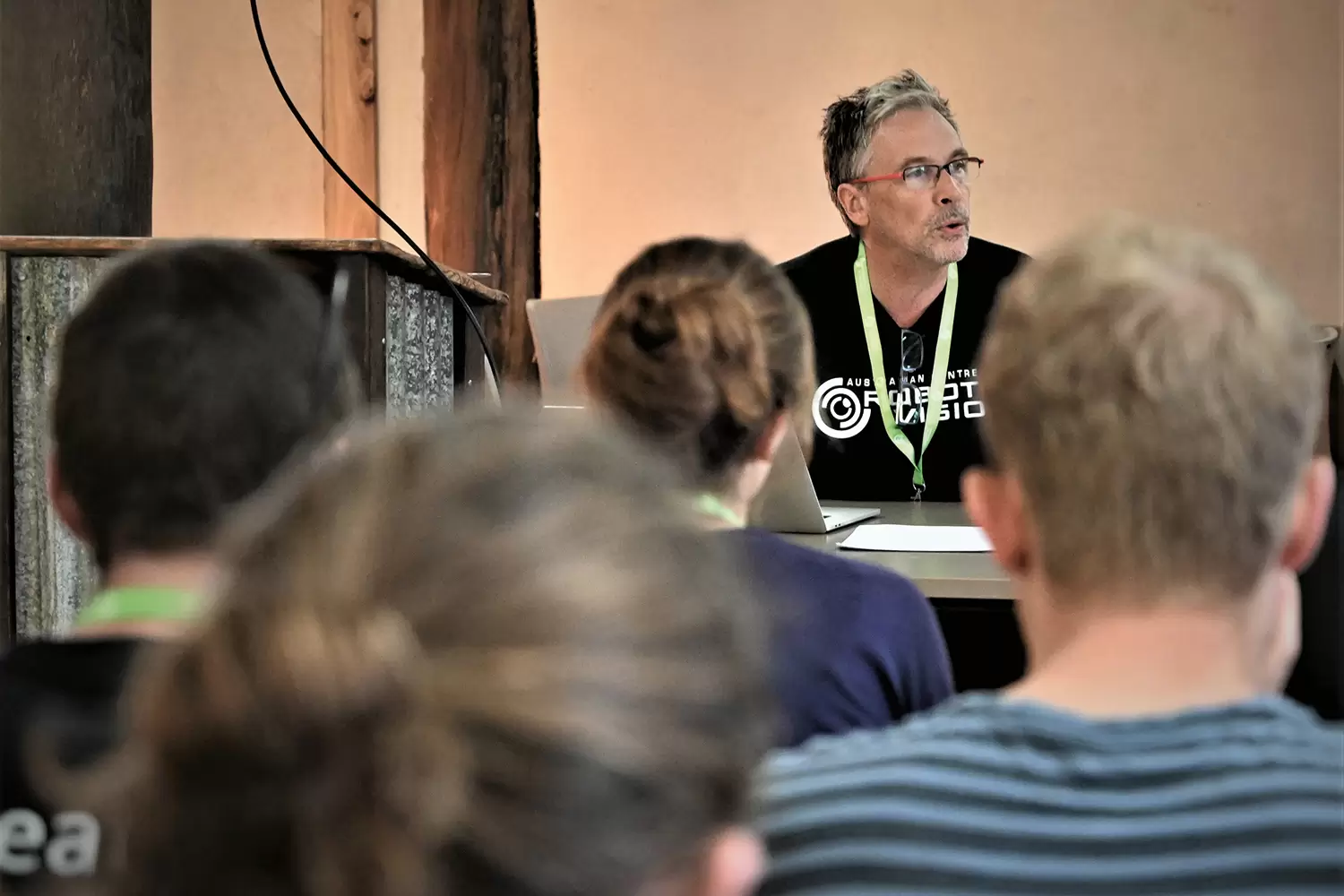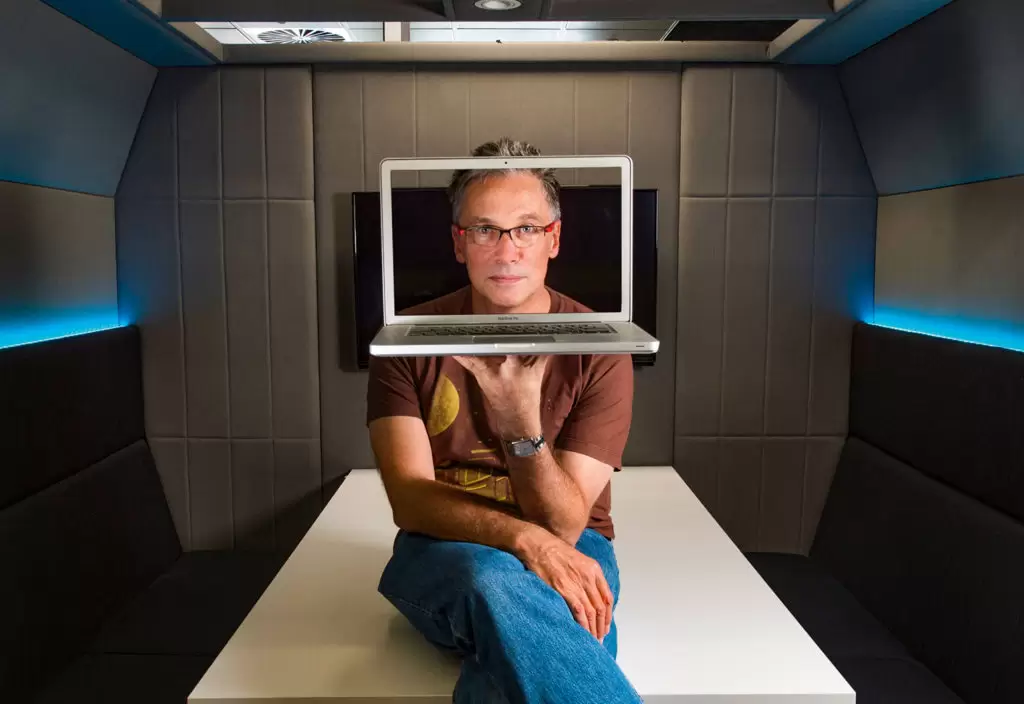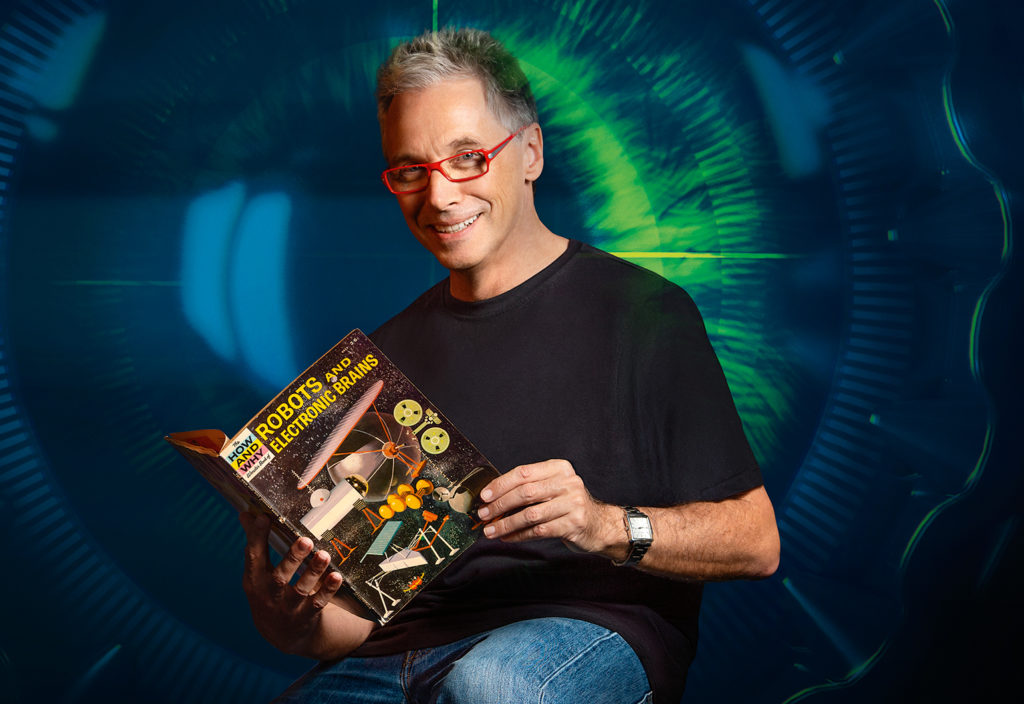From his youth, Peter Corke has had his eye fixed on the future. His career, from artificial intelligence to some of the earliest drones, has been about creating it.
Professor Peter Corke spent a chunk of the 1960s building crystal radio sets with his dad, scrapbooking Project Gemini and Apollo articles, and reading the How and Why Wonder Book of Electronic Brains.
Corke, who was born just before that decade, recalls it as an era of huge optimism about progress, and there was a pervasive effort through society to improve science and technology education.
“Then there was all this popular science stuff: there were cartoon strips in the newspaper which told you about rockets and ion engines and space stations,” he told create.
“It was just crazy to picture a future that seemed really exciting, and now it’s like 2020 and we don’t have very many of those things at all.”
As a roboticist, he’s well aware of the mismatch in public expectation and reality.
In the 1960s, robotics developed alongside computer vision — see the early mobile robot, SRI’s Shakey. But then lidar became affordable as a simple source of geometric information, and it hogged the attention.
Corke is founder of the Australian Centre for Robotic Vision (ACRV), which he directs, and which began in 2014 to help develop robots capable of operating in unstructured environments — i.e. the real world. It’s part of a return to computer vision for autonomous systems, which can offer a richer level of understanding than a point cloud.


Creating robots able to perceive and then respond to new and unknown situations remains very, very difficult, electrical engineer and Queensland University of Technology (QUT) PhD student Doug Morrison told create.
“Doing this where they are able to react to changing environments in real time is even more difficult, because you have a tight computational limit,” he said.
“You can’t sit there thinking for seconds or minutes, because then the world’s changed again.”
Robots are not ubiquitous in society, and have made inroads in “only a very small number of industries”, Corke said.
There are abundant challenges before delivering machines that can carry out many of the tasks we find simple, for example in localisation.
“I think our lab has been one of the most active worldwide in how we can make vision-based methods for localisation and place recognition robust against appearance changes, whether it’s daytime, weather, season or different viewpoints, or if the camera is not in exactly the same position as it was,” said Dr Niko Sünderhauf, a chief investigator at the ACRV, adding that structural changes remain an open problem in robotics.
“If maybe furniture moves or cars move or buildings change and so on, the structure and the geometry of the scene changes. That’s still very hard, because that also makes the appearance change, of course, but there’s a different underlying cause for that. Disentangling the different causes is still very difficult.”
Land, sea and air
Following a bachelor’s degree and a master’s in electronic engineering at University of Melbourne, Corke went to work at CSIRO while completing a PhD in visual serving. After initial work focused on manufacturing, he saw that it made better economic sense to focus on mining problems.
“The penny dropped” for Australian robotics researchers in the mid-90s, he told an IEEE History Center interviewer in 2013.
Corke moved to Brisbane in 1995 and established CSIRO’s Autonomous Systems Lab. Work included automating loading and unloading of draglines, and guidance systems for underground loaders. His group had grown to 40 by the time he left in 2008, and Sydney’s Australian Centre for Field Robotics became his next hotspot for automation in resources.
Mining’s boom-bust cycle (and an admitted effort to restore “karmic balance”) prompted him to diversify into environmental monitoring and agriculture projects.
One sprawling story involves proto-drone work in the late 1990s, for which he equipped a scale model helicopter with sensing and control. The challenges were that the vehicle couldn’t carry much, with hardware much chunkier and less powerful back then.
“I wrote some code that ran the computer onboard the helicopter that did stereo vision to give us an estimate of the vehicle’s height above the ground,” he said.
“It also gave us information about how fast we were moving over the ground, which was handy.”

The project went in two different directions.
The team built a quadcopter with colleagues from the Australian National University in the early 2000s.
“We had to build our own propellers and it flew once for a few seconds. And the frustration is today I can go and buy one from the shop for less than 100 bucks, but we sweated blood for years to build one of the first multi-rotor drones in the world,” Corke said.
The other direction was the stereovision algorithms, which went into a CSIRO autonomous underwater vehicle and were used to calculate distance above the seabed and any current pushing the craft sideways.
“So we can measure that, estimate that, compensate for it. It gave us the ability to do really good underwater control, figure out how far we had moved over time,” Corke said.
“That technology went into the first CSIRO underwater vehicle, which was called Starbug, that then went into COTSBot [later at QUT], which then went into RangerBot. So there’s quite a long heritage of that code, but it started off as a vision system for a scale model helicopter back in the late ‘90s.”
The RangerBot AUV, which is used for monitoring the environment and controlling the invasive crown-of-thorns starfish on the Great Barrier Reef, has received backing from Google, and won a Good Design Award in 2019.
Machine learning for generalisation
Corke nominates vision-based grasping and navigation as two areas where great strides have been made at the ACRV since its beginning.
Morrison was a lead developer on the Cartman — cartesian manipulator — robot that won the ACRV team the prestigious Amazon Picking Challenge in 2017. Corke lists this as another highlight for the centre.
Morrison has developed a generative grasping convolutional neural network, and last year added a multi-vision wrist camera to the robotic system, which builds a “map” of possible grasps as it moves.
He said that deep learning approaches — compared with old sampling-based techniques — have “really allowed robots to generalise their experience from a training set of objects to new objects”.
Another of Corke’s PhD students, mechatronic engineering graduate Robert Lee, is using reinforcement learning to tackle the deceptively tricky task of cloth folding.
It’s an exciting problem, as fabric is “flexible, dynamic, and can move in ways that are hard to predict,” he said.
“The robot can interact with the world directly and learn which actions produce the desired outcome,” he told create of his approach.
“We use this idea to avoid having to manually design algorithms that can model the fabric, and instead learn the best way to fold the fabric directly from image pixels.”
Machine learning has exploded in popularity among roboticists. As ACRV Chief Investigator Niko Sünderhauf and others wrote in the International Journal of Robotics Research in 2018, it had “revolutionised” many parts of computer vision in the five or so previous years, before initial scepticism, then a “surge of deep learning” in robotics followed.
They noted that more than a tenth of papers for the 2018 International Conference on Robotics and Automation contained the keyword “deep learning in robotics and automation”, the most popular term.
Education for all
Asked about current projects, Corke said humbly that “it’s a bit more vicarious” now. His role is more about bringing in resources “so the young ones can play”.
“The only area where I’m still very hands-on is with respect to teaching,” he said.
As head of the Centre of Excellence — which is in its final year — he has become an accidental educator.
It began when he turned 50 in 2008, the same year he clocked up a quarter-century at CSIRO. The milestones told him it was time to move on.
Corke took much of 2009 off, started writing his Robotics, Vision and Control textbook, and began as a Professor at QUT the following year.
Two days before the first lecture, he fell off his bike and broke a knee. He pre-recorded his presentations instead.
Then he “chucked the videos up” on YouTube and forgot about them.
“But I went back a year later and there was a tonne of traffic to those and a lot of really nice comments on them,” he remembers. “And then [massive online open courses, or MOOCs] were starting to be talked about. I said to the university, ‘Hey, let’s make a MOOC]’.”
The MOOCs were well received and evolved into the Robot Academy, which launched in 2017 and has about 200 videos on topics varying from general knowledge to undergraduate engineering level content. A lesson is now watched, somewhere around the world, every minute, and the videos passed one million views in late-2019.
Google Analytics data for the site have brought some pleasant surprises. At the end of last year, 47 per cent of visitors were female. The Academy’s virtual attendees are from all over the world, from the countries you’d expect (the United States, Germany, China) as well as developing nations, with parts of Africa, Papua New Guinea, Bangladesh and Pakistan all bringing in a lot of traffic, according to Corke.
Another pleasant surprise is a kind of accidental celebrity status for the engineering educator.
“A funny side effect of that is when I go to places, there’s lots of students there who know me. I don’t know them, but they know me,” he said with evident amusement.
“I was in Brazil, I was in Pakistan, a few other places last year. And kids were coming up and doing selfies and all that stuff. It’s a bit odd.”
There remains much to be done to make robots that live up to public expectation.
AI — which Corke described as information manipulation without a physical side — has changed industries and lives. Robots, however, aren’t widespread outside of factories — where they’ve been for six decades — or living room vacuuming.
These are the low-hanging fruit, said Corke. Even household chores such as folding or washing up remain “an order of magnitude” trickier.
“The irony is that we have computers that can beat human beings at the game of chess and the game of Go,” he said.
“We don’t have a robot that can reliably pick up a chess piece, which a child could do.”
Dexterous, competent robots able to move around in and make sense of unstructured environments will require engineering expertise from around the world. Democratised learning and algorithms can only help in getting there.
Corke credits his output of educational material — including the Robot Academy, open source machine vision and robotics toolboxes for Matlab — with his 2017 Australian University Teacher of the Year Award.
In less than a decade, he had gone from reluctant sensei to enthusiastic empowerer of the next generation.
“I didn’t want people to say, ‘Whatever happened to Peter Corke?’, ‘Oh, he went to a university and started teaching and we never heard from him again,’” he said of his original trepidation about leaving applied research and development for academia.
“I was really worried about that, so I had written into my contract that I would have minimal teaching duty. I worked quite hard in the negotiation phase to make sure that was written in.
“And the irony, of course, is today that’s the bit that today I enjoy the most.”
